September 8, 2017 at 7:32 pm
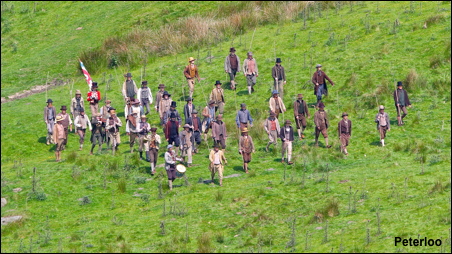
In all the years I have been filming birds in the Pennines I have been disturbed on many occasions but what happened in June this year was quite unique. I had been sat in my hide in a peaceful Oak wood, deep in the Pennines, filming a pair of Green Woodpeckers as they fed their young (see blog 8th July). It was a delightful place to be with the Woodpeckers appearing every hour and providing me with plenty of good photos. Suddenly the Woodpeckers gave alarm calls and drifting through the wood was the sound of a marching band! If that was not bad enough the same notes were repeated incessantly for the next two hours! Eventually I had had enough and I walked out of the wood to the edge of the moor to see what was going on. There in front of me was a scene from nearly two hundred years ago as close on fifty people marched up the valley complete with a vast production team and drones overhead. They were filming next years blockbuster film on the Manchester Peterloo massacre of nearly two hundred years ago. So when you sit and watch this film next year and the marching scene is shown spare a thought for the frustrated photographer sat in the Oak wood nearby and not knowing what was going on!
This weekend we celebrate the tenth anniversary of my weekly blog. For the gallery this week I have included my ten favourite photos out of the fifteen thousand that I have taken in the last decade. It would be nice to think that I will be doing this again in another ten years but realistically I would expect that during that time I will have poured a glass of Laphroaig and disappeared into an Islay sunset!! Click here for my ten favourite photos
September 3, 2017 at 7:14 pm
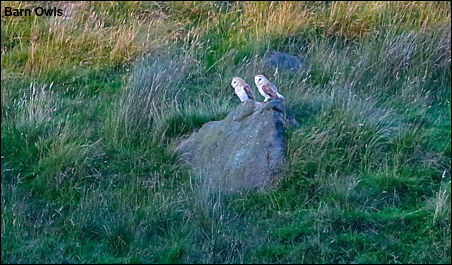
This weeks photo is of two recently fledged Barn Owls about to take their first evening flight. It is only a record shot taken from the car more than 400 yards away and these two were part of a brood of six that fledged from a barn just a few yards away. The significance of the photo is that with these Barn Owls I have, in the last two months, now photographed all five species of Pennine Owls something I have never done in one season in forty seven years before.
Once young Barn Owls can fly they are still fed by the male for up to six weeks, usually on top of the dry-stone walls that surround the barn. Three years ago I spent many weeks trying to capture the illusive food-pass from the male to the young. On many nights the young, the hide and flash were in the wrong place but on other nights it all came good and this weeks gallery shows some of the more successful shots. The main problem is that it is not possible to re-focus once it has gone dark and you are only left with silhouettes in your view finder. The male Owl is the one with the dirty face! Click here
August 27, 2017 at 7:14 pm
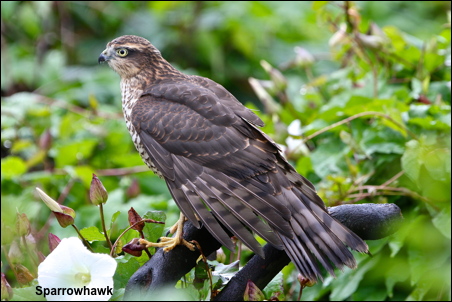
After a gap of almost a year a Sparrowhawk has returned to hunt our feeding birds. It makes a pleasing picture at the back of the garden and this photo must be one of the best photos I have ever taken from the bedroom window! This year there has been a sudden decline in local Sparrowhawks and for the first time in more than thirty years I have not proved breeding in Hopwood woods or Golf-course. Click here
There are now the first signs of the return of Autumn with 245 Lapwings already present on the roof of the local industrial estate.
August 20, 2017 at 6:33 pm
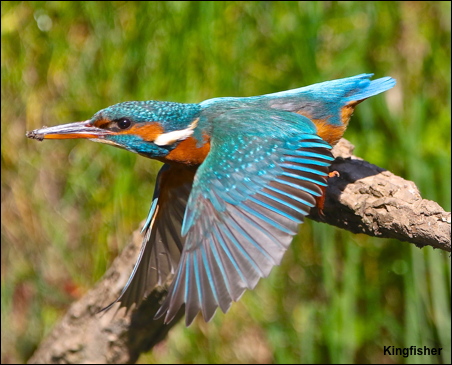
For 45 years I have been filming and closely monitoring breeding Kingfishers on a small stretch of one of Lancashires main rivers. During that time there have been many successes but also a fair number of failures.
Three years ago one pair tried three times to rear young and on each occasion the young were drowned in the nest-chamber as the water levels of the river rose in spate floods. Last year there was no flooding and two broods of young fledged successfully.
This year the Kingfishers decided to nest on a small tributary stream to the main river which meant it was impossible for the tunnel to be flooded. Unfortunately the stream ran through a field where the farmer released his young cattle from May onwards. One week before fledging the first brood of young were suffocated in the nest-chamber when the earth above collapsed due to the weight of cattle. Unperturbed two weeks later the Kingfishers dug a new tunnel and stated again. Last month, when the young Kingfishers were within a week of fledging again, the cattle returned and this time totally demolished the whole bank! A sad end to all their work this year and failures that would have gone unrecorded had I not been closely monitoring this pair. Click here
August 12, 2017 at 7:30 pm
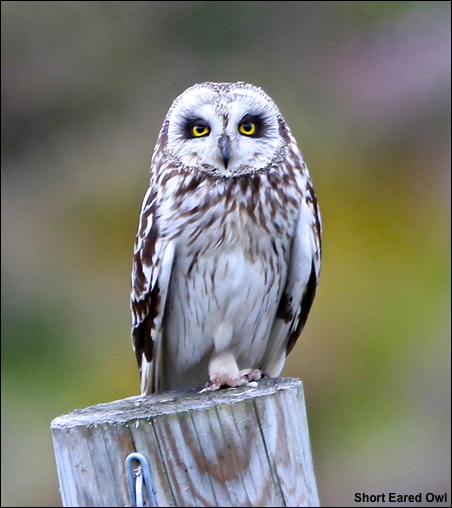
Today is the start of the Grouse shooting season and as we all know the gamekeepers have been out with their guns well before the twelfth. Apart from the odd Buzzard this weeks Short Eared Owl was the only raptor seen in our recent five day visit to Speyside. The Hen Harriers that once inhabited these moors have been heavily persecuted. In England this year only three pairs of Hen Harriers have bred successfully and all of these were on forestry land not Grouse moorland. It is a national disgrace which this Government seems incapable of solving.
When you are involved with wildlife all your life events happen which you know you will never see again. One such event occurred as we drove south on the A9 – one of Scotlands busiest roads. I suddenly noticed, on the other side of the road, a Woodcock with four day old young that she was about to take across the road! As we sped past she flew over the bonnet of the following car and landed on our side of the road from where she would have called them across to her. Whether they made it we shall never know but as there was a lull in the following traffic I like to think that they did.
This weeks gallery includes a small selection of Speyside photos including the Kingfisher that was present at the Osprey fishing pool and is still there today! Click Here
August 5, 2017 at 12:27 pm

When an Osprey dives in pursuit of prey the impact at 40 miles per hour is enough to take the bird almost completely underwater as shown in this weeks blog photo. Remarkably the Osprey can then take off with its prey, even though it is soaked through. In comparison the Sea Eagle has to pluck its fish off the surface of the water for it is too large to take off from the sea and would have to swim to the shore if it got it wrong.
Last week I visited Aviemore to film the fishing Ospreys. The light at 5.00am was not good but apparently was better than it had been on the days before I arrived! There was an added bonus when a Kingfisher turned up one morning and provided action from another spectacular aquatic hunter. Click here







